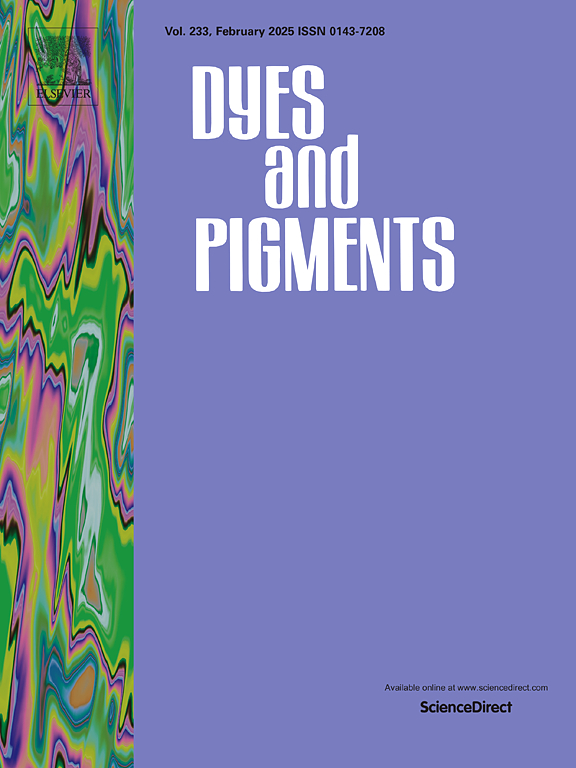多咖啡酸微球用于白色织物上生动的光子晶体结构颜色
IF 4.1
3区 工程技术
Q2 CHEMISTRY, APPLIED
引用次数: 0
摘要
由微球自组装形成的光子晶体由于其独特的结构颜色,在纺织品着色方面得到了广泛的研究。黑色添加剂,如炭黑和石墨烯,已被用于构建高饱和结构色织物。然而,这些物质在光子晶体结构内的色散会影响织物的颜色均匀性。本文选择碘酸钾(KIO3)作为氧化剂,催化咖啡酸(CA)的快速聚合,制备出形貌规则、粒径均匀、外观颜色特别深的多咖啡酸(PCA)微球。此外,通过调节重力沉积PCA微球的粒径,在各种白色织物上成功实现了充满活力的结构色彩,包括棉、丝和聚酯。此外,通过不同比例混合沉积两种不同尺寸的PCA微球,得到了混合结构色,进一步扩大了结构色域。水性聚氨酯(WPU)的引入在一定程度上增强了PCA光子晶体在织物表面的稳定性。本研究不仅介绍了构建光子晶体结构色的新型微球基元,而且提出了创造充满活力和高饱和结构色织物的创新策略。本文章由计算机程序翻译,如有差异,请以英文原文为准。

Polycaffeic acid microspheres for vivid photonic crystal structural color on white fabrics
Photonic crystals formed through the self-assembly of microspheres have been extensively studied for textile coloration due to their unique structural colors. Black additives, such as carbon black and graphene, have been utilized to construct highly saturated structural color fabrics. However, the dispersion of these substances within the photonic crystal structure affects the color uniformity of the fabric. Herein, potassium iodate (KIO3) was selected as an oxidant to catalyze the rapid polymerization of caffeic acid (CA), producing polycaffeic acid (PCA) microspheres with a regular morphology, uniform particle size, and particularly dark appearance. Furthermore, by modulating the particle size of gravity-deposited PCA microspheres, vibrant structural colors were successfully achieved on various white fabrics, including cotton, silk, and polyester. Additionally, by mixing and depositing PCA microspheres of two different sizes in various ratios, hybrid structural colors were attained, further expanding the structural color gamut. The introduction of waterborne polyurethane (WPU) enhanced the stability of PCA photonic crystals on the fabric surface to a certain extent. This research introduces not only novel microsphere primitives for constructing photonic crystal structural colors but also proposes innovative strategies for creating vibrant and highly saturated structural color fabrics.
求助全文
通过发布文献求助,成功后即可免费获取论文全文。
去求助
来源期刊

Dyes and Pigments
工程技术-材料科学:纺织
CiteScore
8.20
自引率
13.30%
发文量
933
审稿时长
33 days
期刊介绍:
Dyes and Pigments covers the scientific and technical aspects of the chemistry and physics of dyes, pigments and their intermediates. Emphasis is placed on the properties of the colouring matters themselves rather than on their applications or the system in which they may be applied.
Thus the journal accepts research and review papers on the synthesis of dyes, pigments and intermediates, their physical or chemical properties, e.g. spectroscopic, surface, solution or solid state characteristics, the physical aspects of their preparation, e.g. precipitation, nucleation and growth, crystal formation, liquid crystalline characteristics, their photochemical, ecological or biological properties and the relationship between colour and chemical constitution. However, papers are considered which deal with the more fundamental aspects of colourant application and of the interactions of colourants with substrates or media.
The journal will interest a wide variety of workers in a range of disciplines whose work involves dyes, pigments and their intermediates, and provides a platform for investigators with common interests but diverse fields of activity such as cosmetics, reprographics, dye and pigment synthesis, medical research, polymers, etc.
 求助内容:
求助内容: 应助结果提醒方式:
应助结果提醒方式:


